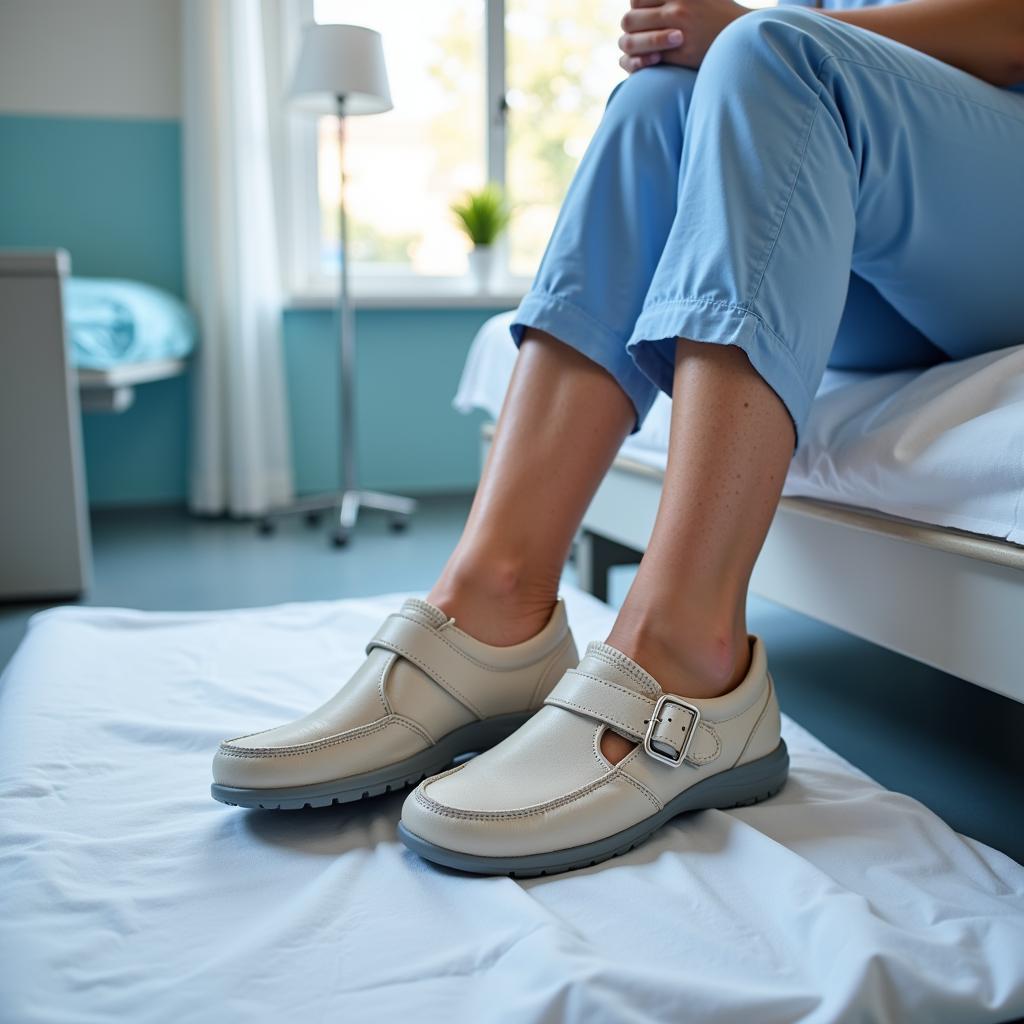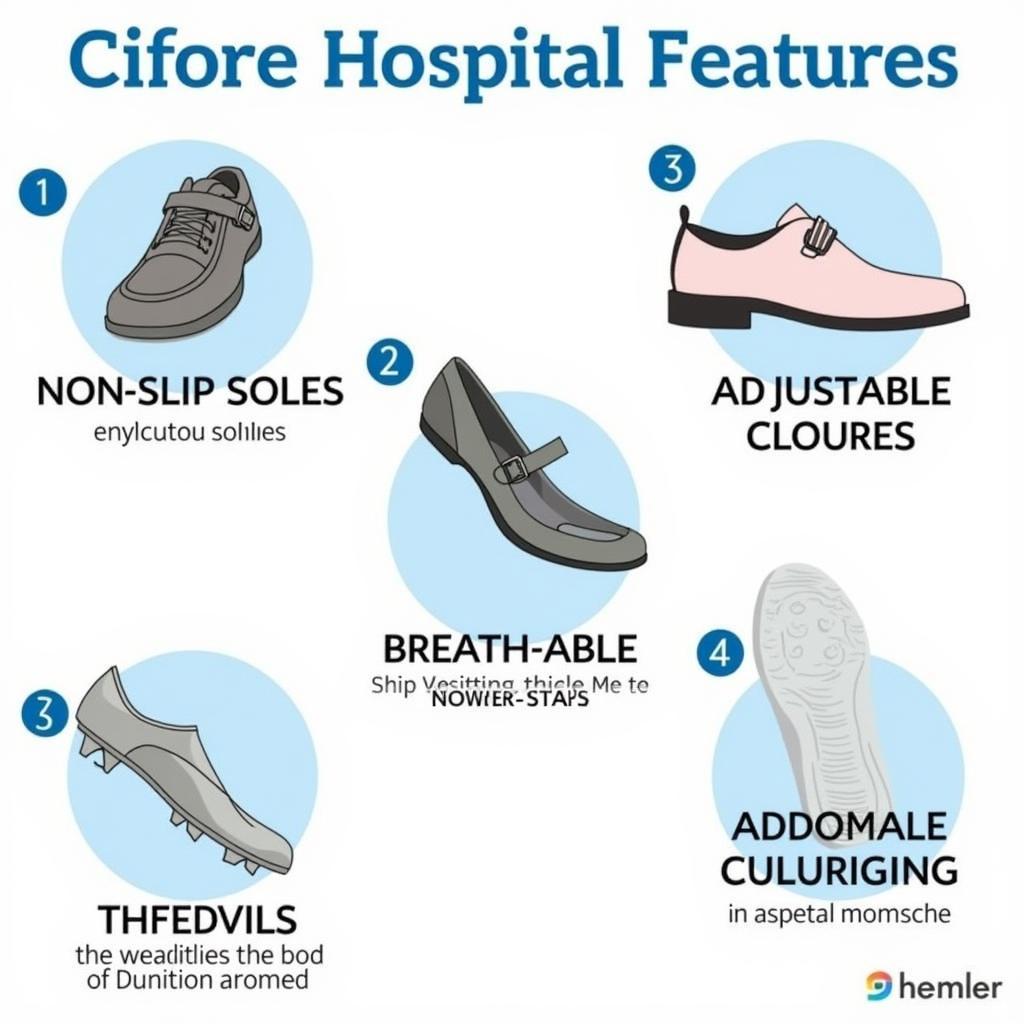When you’re a patient in the hospital, your comfort is paramount. While you might not immediately think of footwear as a top priority, having the right hospital shoes can significantly impact your well-being during your stay.
 Comfortable Hospital Shoes for Patients
Comfortable Hospital Shoes for Patients
Why Standard Shoes Won’t Cut It
Your everyday footwear likely won’t meet the specific needs and regulations of a hospital environment. Here’s why:
- Safety: Hospitals prioritize fall prevention. Many standard shoes lack the necessary grip for slippery floors.
- Swelling: Illness and certain medications can cause swelling in the feet and ankles. Regular shoes might become too tight, hindering circulation and causing discomfort.
- Hygiene: Hospitals maintain strict hygiene standards. Your outdoor shoes carry dirt and germs that could pose a risk in a sterile setting.
- Convenience: Hospital stays often involve frequent walks to the restroom or for treatments. Easy-to-slip-on and adjustable shoes make these trips more manageable.
 Important Features of Hospital Shoes
Important Features of Hospital Shoes
What to Look for in Hospital Shoes for Patients
Selecting the appropriate hospital shoes can improve your comfort and safety during your hospital stay. Here’s a breakdown of the essential features to consider:
1. Non-Slip Soles
Grip is crucial. Look for shoes with rubber or non-slip soles to prevent accidents on potentially slippery hospital floors.
2. Adjustable Closures
Swelling in the feet and ankles is common during hospital stays. Opt for shoes with adjustable closures like Velcro straps or laces to accommodate changes in foot size.
3. Breathability
Hospital environments can be warm. Choose shoes made from breathable materials like canvas or mesh to prevent overheating and keep your feet dry.
4. Support and Cushioning
Even short walks can be tiring. Look for shoes with good arch support and cushioning to minimize foot fatigue and discomfort.
5. Easy On and Off
Encompass Health Rehabilitation Hospital of Abilene prioritizes patient comfort and mobility. Choose slip-on shoes or those with adjustable closures that are easy to manage, especially if you have limited dexterity.
Types of Hospital Shoes
- Non-Skid Socks: These are ideal for short-term stays or for wearing around your room. They provide warmth, grip, and some cushioning.
- Slippers with Closed Backs: These offer more support than socks and are suitable for walking short distances. Look for slippers with a firm heel counter for added stability.
- Adjustable Strap Shoes: These are a popular choice for their versatility and ease of use. Look for options with a wide opening for easy on and off.
Tips for Choosing the Best Fit
- Try Them On: Whenever possible, try on shoes before purchasing to ensure a comfortable fit.
- Consider Your Needs: Think about your mobility level and the length of your hospital stay to determine the level of support and features you’ll need.
- Don’t Forget About Socks: Bring comfortable, breathable socks to wear with your hospital shoes.
- Consult with Your Doctor: If you have any specific foot conditions, consult with your doctor or a podiatrist for recommendations.
Conclusion
Choosing the right Hospital Shoes For Patients is an often-overlooked aspect of ensuring a comfortable and safe hospital experience. By prioritizing features like non-slip soles, adjustability, and support, you can significantly improve your well-being during your stay. Remember to discuss any concerns with your healthcare provider and choose footwear that meets your individual needs.
FAQs
1. Can I wear my regular slippers to the hospital?
While some hospitals might allow regular slippers, it’s best to check their policy. Prioritize slippers with closed backs and non-slip soles for safety.
2. Where can I buy hospital shoes?
Hospital shoes are available at most drugstores, medical supply stores, and online retailers.
3. Can I wash hospital shoes?
Check the care instructions on your specific shoes. Many are machine washable, making it easy to keep them clean.
4. What if I have a cast or bandage on my foot?
If you have a cast, your doctor or nurse will advise you on appropriate footwear. Special cast shoes are often recommended.
5. What does a yellow wristband mean at a hospital? What does a yellow wristband mean at a hospital?
A yellow wristband typically signifies a fall risk. It’s a visual cue for hospital staff to take extra precautions to ensure your safety.
You might also want to know about:
- Hospital maps, like the St. Agnes Hospital map, which can help you navigate the facility.
- Information about specialized facilities, such as the Conway Regional Rehabilitation Hospital, which offers comprehensive rehabilitation services.
- The Johnston Willis Hospital map can be found on their website, assisting you with directions and locating departments.
For any further inquiries or assistance, please don’t hesitate to contact our 24/7 support team at Phone Number: 02437655121, Email: [email protected] or visit us at 298 Cau Dien Street, Minh Khai Ward, Bac Tu Liem District, Hanoi, Vietnam.